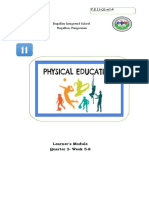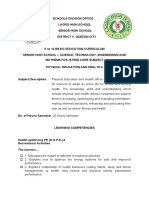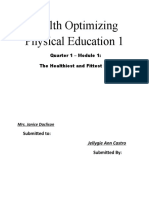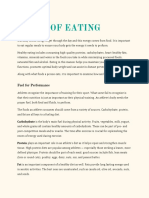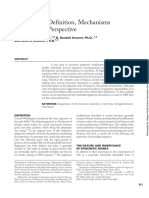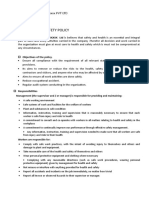Physical Education 1: Senior High School: Grade 11 1 Quarter: Module 1
Physical Education 1: Senior High School: Grade 11 1 Quarter: Module 1
Uploaded by
nash MadlaOriginal Description:
Original Title
Copyright
Available Formats
Share this document
Did you find this document useful?
Is this content inappropriate?
Report this DocumentCopyright:
Available Formats
Physical Education 1: Senior High School: Grade 11 1 Quarter: Module 1
Physical Education 1: Senior High School: Grade 11 1 Quarter: Module 1
Uploaded by
nash MadlaCopyright:
Available Formats
PHYSICAL EDUCATION 1
SENIOR HIGH SCHOOL: GRADE 11
1st QUARTER: MODULE 1
Name: ________________________________________ Section: ________________________
Parent Signature: ______________________________ Date Submitted: ________________
2
COURSE OUTLINE: ORAL COMMUNICATION
WEEK TOPICS LEARNING OBJECTIVES REFERENCES
NO.
1 Introduction to Physical Education 1. Define Physical Education and Physical Fitness
and Physical Fitness
2. Identify the importance of Physical Fitness
2 Health Related and Skill Related 1. Define Health Related and Skill Related Physical
Physical Fitness Fitness
2. Differentiate Health Related Fitness from Skill
Related Fitness
3. Identify the components of Health Related and
Skill Related Physical Fitness
3 Aerobics 1. Distinguish aerobic from muscle and bone
strengthening activities.
4 Bone and Muscle Strengthening 1. Distinguish aerobic from muscle and bone
Exercises strengthening activities.
2. Engages in moderate to vigorous physical
activities (MVPAs) for at least 60 minutes most
days of the week in a variety of settings in- and
out- of school
GARDNER COLLEGE wwww.gardner.edu.ph
3
PRE-TEST:
Instruction: In this activity, you will be assessed on how ready you are to take the lessons
on the concepts of aerobic, bone strengthening and muscle strengthening exercises.
Choose the best answer.
1. The ability of the heart and lungs to deliver oxygen to working muscles during
physical activity for a long period of time is called ___ ?
a. Cardiovascular Endurance c. Body Composition
b. Flexibility d. Muscular Strength
2. What is the advantage of exercise?
a. Improved quality of life c. Stress Relief
b. Decrease chronic disease d. All of the above
3. Doing muscular strengthening exercises also develops ones _____?
a. Cardiovascular Endurance c. Flexibility
b. Muscular Endurance d. Bone strength
4. If Randy perform short bursts of lifting very heavy weights with low repetitions, this
type of exercise is called ___?
a. aerobic exercise c. bone strength exercise
b. muscular strength exercise d. anaerobic exercise
5. The ability of a muscle to exert force for a brief period of time is referred as __?
a. Muscular Endurance c. Cardiovascular endurance
b. Muscular Strength d. Flexibility
6. Push up, weight lifting, plyometrics are examples of what exercises?
a. Muscular Endurance c. Cardiovascular Endurance
b. Muscular Strength d. Flexibility
7. Which of the following is not a primary benefit of regular cardiovascular
exercise?
a. Increased ability to take in and use c. Lower blood pressure
oxygen
b. Improved balance d. Lower pulse rate
GARDNER COLLEGE wwww.gardner.edu.ph
4
8. What does F.I.T.T. stands for?
a. Fitness, Intelligence, Total Turnout
b. Frequency, Intensity, Temperature, Time
c. Frequency, Intensity, Time, Type
d. Fun, Intensity, Teamwork, Trust
9. Running, cycling, swimming, and dancing are all examples of what type of
exercise?
a. resistance exercise c. muscular strengthening
b. aerobic exercise d. flexibility exercises
10. When weight lifting for muscular strength, one should lift ____weight and do____
repetitions?
a. less: fewer c. more: many
b. less: more d. more: fewer
GARDNER COLLEGE wwww.gardner.edu.ph
5
NOTE TO STUDENT AND PARENTS/GUARDIANS:
Grade 11 Physical Education and Health offers practical learning for students to effect
change on lifestyle towards an active and healthy living. The concepts and skills
expected to be developed at the end of the semester as stated in each learning
competencies is intended to prepare the students to manage relevant and important
information related to fitness and health.
In this module you will learn about the concepts of physical education, physical fitness,
aerobic, bone strengthening, and muscle strengthening exercises and its impact to
over-all health. As you go along in this module, you will be constantly asked to perform
different activities as it is believed that learning will be faster if you experienced it first-
hand. These concepts will ultimately allow you to understand better the following:
1. Physical Education and its contribution to the students’ over-all development
and physical fitness
2. The differences of the two exercises, and
3. Its relationship for you to appreciate and engage in physical activities as part of
a healthy lifestyle.
These lessons on exercise for fitness empowers the students to engage in exercise
through purposive, careful planning, and skillful execution of aerobic and muscle- and
bone strengthening activities and constantly appraise progress as to how much impact
does these exercises affect lifestyle and health.
GARDNER COLLEGE wwww.gardner.edu.ph
6
LESSON PROPER (WEEK 1): Introduction to Physical Education
What is Physical Education?
Physical Education is an integral part of the education program which aims to
promote optimum development of an individual physically, mentally, socially,
emotionally and even spiritually in the performance of properly selected physical
activities.
One of the objectives of physical education in the school system from grade one to
college is to improve the overall fitness of the students.
FITNESS
Fitness is the ultimate goal of physical education. It is referred to as the ability to
live a healthy, useful and satisfying life.
ILLNESS
Illness is the ill feeling and /or symptoms associated with disease or a
circumstance that upsets homeostasis.
HEALTH
Health is the optimal well-being that contributes to the quality of life. It is more
than freedom from disease and illness, through freedom from disease is important to
good health. Optimal health includes high-level mental, social, emotional, spiritual and
physical wellness within the limits of one’s heredity and personal abilities
WELLNESS
Wellness is the integration of many different components (mental, social,
physical, emotional and spiritual) that expand one’s potential to live (quality of life) and
work effectively and make a significant contribution to society. Wellness reflects how
one can feels (a sense of well being) about life as well as one’s ability to function
effectively. Wellness, as opposed to illness (a negative), is sometimes described as the
positive components.
Physical Fitness
Physical Fitness is the capacity of the individual to accomplish his/her regular
daily activities without undue fatigue and still has an ample amount of reserved energy
to enjoy leisure and meet emergencies.
What does it mean to be physically "fit"?
Physical fitness is more than being able to run a long distance or lift a lot of
weight at the gym. Being fit is not defined only by what kind of activity you do, how
long you do it, or at what level of intensity.
GARDNER COLLEGE wwww.gardner.edu.ph
7
Physically fit person has the ability to last, to bear up, to withstand stress, and to
persevere under difficult circumstances where an unfit person would give up. Physical
fitness is the opposite of being fatigued from ordinary efforts, to lacking the energy to
enter zestfully into life’s activities, and to becoming exhausted from unexpected,
demanding physical exertion."
Being physically fit is striving to live better. It will help you bring your body, mind
and spirit into concert.
Physical fitness is both physical and mental, lowering your risk for many diseases,
while helping to increase longevity and improve your self-esteem and ability to
manage stress. You will be more productive and safe at work, and better equipped to
hit home runs when they are needed (Mc Glynn)
IMPORTANCE OF PHYSICAL FITNESS
• Improves the quality of life.
• Reduce the risk of heart diseases
• Relieves depression
• Prevents certain types of cancer
• Increases the good (HDL) cholesterol
• Enhance self image
• Relieves stress and anxiety
• Improves mental sharpness
GARDNER COLLEGE wwww.gardner.edu.ph
8
ACTIVITIES/ASSIGNMENTS/PROJECTS:
Activity 1.
Instructions: What are the 5 components of an individual that Physical Education aims
to develop?
1.
2.
3.
4.
5.
Activity 2.
Instructions: How will you tell if you are “Physically Fit”?
Activity 3.
Instructions: Why is Physical Education important in the educational system?
GARDNER COLLEGE wwww.gardner.edu.ph
9
LESSON PROPER (WEEK 2): Health and Skill Related Fitness
HEALTH RELATED FITNESS
Health related fitness is a function of the body’s adaptation to exercise. It could
be developed and maintained through a regular and proper exercise program. These
are the five basic components of health related fitness. There are as follows:
COMPONENTS OF HEALTH RELATED FITNESS
1. Cardiorespiratory endurance (cardiorespiratory fitness)
Cardiorespiratory endurance is the ability of the body's circulatory and
respiratory systems to supply fuel during sustained physical activity. To improve your
cardiorespiratory endurance, try activities that keep your heart rate elevated at a
safe level for a sustained length of time such as walking, swimming, or bicycling. The
activity you choose does not have to be strenuous to improve your cardiorespiratory
endurance. Start slowly with an activity you enjoy, and gradually work up to a more
intense pace.
2. Flexibility
Flexibility is the range of motion around a joint. Good flexibility in the joints can
help prevent injuries through all stages of life. If you want to improve your flexibility,
try activities that lengthen the muscles such as swimming or a basic stretching
program.
3. Muscular strength
Muscular strength is the ability of the muscle to exert force during an activity. The
key to making your muscles stronger is working them against resistance, whether
that be from weights or gravity. If you want to gain muscle strength, try exercises
such as lifting weights or rapidly taking the stairs.
4. Muscular endurance
Muscular endurance is the ability of the muscle to continue to perform without
fatigue. To improve your muscle endurance, try cardiorespiratory activities such as
walking, jogging, bicycling, or dancing.
5. Body composition
Body composition refers to the relative amount of muscle, fat, bone, and other
vital parts of the body. A person's total body weight (what you see on the bathroom
scale) may not change over time. But the bathroom scale does not assess how
much of that body weight is fat and how much is lean mass (muscle, bone, tendons,
and ligaments). Body composition is important to consider for health and managing
your weight!
GARDNER COLLEGE wwww.gardner.edu.ph
10
SKILL RELATED FITNESS
Skill Related Fitness refers to the quality of one’s movement in developing a
higher degree of skills in any physical activities. Many of these components work closely
together and can be trained for by similar modes. However, specificity does exist, and
such skills cannot be categorized in general.
A combination of these skills or abilities usually determines a skilled performance in a
particular sport. Note also that a high level of health-related components may make
skill acquisition easier. One cannot improve skill if one is fatigued and lacking strength or
flexibility.
COMPONENTS OF SKILL RELATED FITNESS
1. Agility, balance and coordination. (ABC)
Agility is the ability to change body positions quickly and accurately to the
indicated response or situation. Balance refers to the ability of a person to maintain
a specific body position while still or in motion. Coordination is the speed and
accuracy of correct muscle response to produce a desired movement.
2. Power
Power is the application of strength and speed during a muscular movement.
Power equals force times velocity and has to do with the speed of the contraction
against less than maximal resistance. Power is closely related to dynamic strength,
with speed or quickness of movement as the added dimension. Although strength,
speed and power are related, strength alone will not develop power.
3. Speed
is the ability to move the body or a region of the body as rapidly as possible from
one point to another. Speed is the rate of movement, or the amount of time it takes
for a body or object to travel between two points. Speed usually refers to running
speed, as in the sprints in track or football. However, speed can be performed as leg
speed in soccer kicking, arm speed in throwing a baseball, and body speed
(acceleration) necessary in gymnastics.
4. Reaction Time
This refers to the time lapse between the presentation of the stimulus (sound-
sight-touch) and the first muscular movement of the performer. Reaction time
enables the performer to move faster, which can affect other skill components such
as speed and power. Reaction time can be improved through the use of many
developmental programs, such as strength and speed improvement.
GARDNER COLLEGE wwww.gardner.edu.ph
11
ACTIVITIES/ASSIGNMENTS/PROJECTS: ORAL COMMUNICATION
Activity 1.
Instructions: What is the difference between Health Related Fitness and Skill Related
Fitness?
Activity 2.
Instructions: Define the following components of Health Related Fitness.
1. Cardiorespiratory endurance -
2. Flexibility -
3. Muscular strength -
4. Muscular endurance -
5. Body Composition -
Activity 3.
Instructions: Give exercise which will help develop the following Skill Related Health
components.
1. Agility, balance and coordination -
2. Power -
3. Speed -
4. Reaction Time -
GARDNER COLLEGE wwww.gardner.edu.ph
12
LESSON PROPER (WEEK 3): Aerobic
Aerobic exercise can be defined as any form of exercise or activity that uses the
aerobic metabolism. which means that oxygen is a vital factor in delivering energy to
sustain any activity. Aerobic exercise is used to develop cardiovascular fitness one of
the five and the most important component of health-related fitness.
What happens when you engage in aerobic exercise?
Aerobic exercise makes your heart, lungs, and blood vessels more efficient and
capable of moving more oxygen-carrying blood in every single pump throughout the
body thereby improving not only the cardiovascular system but also muscle and bone
fitness
Why aerobic? What are examples of Aerobic activities or exercises?
Aerobic exercises are accessible, it is efficient in terms of cost and space, offers
convenience, and does not require expensive equipment. With a little creativity and a
right formula, you can put together a fitness routine that includes a wide range of fun
and effective aerobic exercises to build muscle, burn calories, and feel better.
Walking, jogging, dancing, stair climbing, riding your bicycle, playing sports, swimming,
rope jumping or even doing household chores are some of the few moderate to
vigorous aerobic activities that you can enjoy...
To develop your aerobic capacity, you need to have a purposive, planned, and skillful
execution of your activity or workout. Below are the factors to guide you in designing
your aerobic workout.
GARDNER COLLEGE wwww.gardner.edu.ph
13
How to determine your target heart rate zone?
Calculating the Target Heart Rate Zone using the Heart Rate Reserve:
For example, say your age is 16 and you want to figure out your target heart rate zone
for vigorous aerobic exercise using the HRR method. Follow these simple steps:
A. Subtract 16 from 220 to get 204 — this is your maximum heart rate.
B. Check your resting heart rate first thing in the morning. Say it's 70 beats per minute. C.
Calculate your HRR by subtracting 70 from 204. Your HRR is 134.
D. Multiply 134 by 0.7 (70%) to get 93.8, then add your resting heart rate of 70 to get
163.8 beats per minute as your lower limit.
E. Now multiply 134 by 0.80 (80%) to get 107.2, then add your resting heart rate of 70 to
get 177.2.
Your target heart rate zone for vigorous exercise is: Lower Limit: 163.8 beats per minute
Upper Limit: 177.2 beats per minute.
Ideally, target heart rate zone lower limit should not be lower than 60% of your HRR.
GARDNER COLLEGE wwww.gardner.edu.ph
14
ACTIVITIES/ASSIGNMENTS/PROJECTS: ORAL COMMUNICATION
Activity 1.
Instructions: Using the HRR method, determine your aerobic exercise target heart rate
zone. Work within the range of 60%-95%. Ex 60% and 70%
Activity 2.
Instructions: Using your output in activity 1, design your 1-week aerobic workout plan
taking other factors such as frequency, time, and type into consideration. Use the
format below. Day 1 is given as an example.
1. Maximum Heart Rate:
2. Resting Heart Rate:
3. Heart Rate Reserve:
4. Target Heart Rate Zone: Lower Limit: __________ Upper Limit: __________
Table – Aerobic Exercise Plan
Frequency Intensity Type of Exercise/Activity Time/Duration
Sun Rest
Mon 170 bpm (80%) HIIT (high intensity 15 minutes
interval training)
Tue
Wed
Thurs
Fri
Sat
GARDNER COLLEGE wwww.gardner.edu.ph
15
Activity 3.
Instructions: Supply the following columns below with data from your first week of
exercise using your aerobic workout plan. Example is given below for your reference.
Day Description Zone %HRR Activity How it Perceived
Feels Benefits
12-minute Lower 75 Tabata Gasp Fat
1 vigorous Limit words or burning
aerobic short increases
workout phrases. and
Breathing improves
hard. endurance
GARDNER COLLEGE wwww.gardner.edu.ph
16
LESSON PROPER (WEEK 4): Bone and Muscle Strengthening Exercises
Muscle and bone strengthening exercises are also called as strength training, it is an
exercise used to improve the muscular strength, a health-related component of fitness,
and increase muscle mass as well as bone density by exposing the group of muscles
and bones to a resistance in a form of weight or force.
This is a high impact, very heavy form of exercise as the muscle have to be deliberately
overloaded and experience fatigue, meaning have to work more than its usual
capacity, to be able to improve.
Activities or exercises like plyometric or jumping exercises, weight lifting, basketball,
volleyball, running, gymnastics, and exercises that uses equipment like resistance bands
are good exercises or activities to develop your bone strength.
Going back again in your Junior High experience wherein you were basically
introduced to the principle of overload and the benefits of strength training as a means
to improve and maintain your functional physical capacity to perform daily tasks and
even during emergency. You learned that strength training develops not only muscular
strength but also endurance and muscle tone.
In continuation of your strength training experience and to better understand the
principle of overload and FITT as applied in muscle and bone strengthening, you will be
taught here in lesson two how apply all those concepts together and come up with a
muscle and bone strengthening workout plan.
Modified Hopscotch. Create a hopscotch grid. In each box, you write one form of
exercise with corresponding number of repetitions like squat 15 times, push up 20 times,
burpees 10 times, curl up 20 times, leg raises 15 times, etc.
Stand with your back facing the grid and small stone (preferably flat) in your hand,
throw the stone with an aim of having it to land in any grid.
Hopscotch your way to the grid where your stone lands and perform the exercise.
GARDNER COLLEGE wwww.gardner.edu.ph
17
FITT Applied to Strength Training
In strength training or exercises FITT is interpreted and applied as the following:
Frequency: Just like in aerobic workout, this factor will guide how many days in a week
you should do strength training. From the illustration above, muscular and bone
strengthening exercises can be safely done in 1-2 non-consecutive days in a week and
should follow after a hard exercise session.
Intensity: As in any workout target, intensity in the form of overload, is the most
important factor to consider in muscular and bone strengthening workout. But, unlike
aerobic workout, strength training intensity is determined using the amount of resistance
or load. Sets, repetitions, and load volume are also aspects to consider in setting the
desired intensity. Overload should be measured intelligently or else over exertion and
injury will be most likely making the workout counter-productive.
Ex. To determine your starting load to develop your pectorals, deltoids, triceps, and
abdominals using push up, you perform push up as many times as these muscles can
perform the exercise up to the point of muscle failure.
Muscle failure is the moment when your muscles are not capable of exerting the
amount of force necessary to complete the current repetition, with a given load.
If in case you are using an implement, like for example a dumbbell, then simply you just
have to perform, triceps curl up to the point of muscle failure.
Time: In this case, time or duration of the muscle and bone strengthening workout is
determined by the number of sets, repetitions, and exercises to be performed in a given
exercise session. Beginners normally start with a single set while those who have spent 6
or more weeks depending on progress can have 2-3 sets.
Ex. 1 set; 12 repetitions per exercise X number of target muscles or body parts
Biceps: 2 exercises; 1 set; 12 repetitions each Triceps: 2 exercises; 1 set; 12 repetitions
each Pectorals: 2 exercises; 1 set; 12 repetitions each Abdominals: 4 exercises; 1 set; 12
repetitions each
Type: Refers to the kind of exercises or method you are using. Muscle and bone
strengthening can be achieve using body weight, free weights, weight machines,
exercises such as plyometrics, resistance bonds, and sports such as basketball, football,
and volleyball. Daily activities such as lifting, climbing stairs, pushing heavy objects also
helps in improving muscle and bone strength.
GARDNER COLLEGE wwww.gardner.edu.ph
18
ACTIVITIES/ASSIGNMENTS/PROJECTS: ORAL COMMUNICATION
Activity 1.
Instructions: Choose 4 parts of your body you want to improve.
Considering COVID-19 pandemic, identify four different items found at home (your
home) that you can use to improve those body parts that you have chosen. Also, list
four different household chores that you can do for this purpose.
1.
2.
3.
4.
Activity 2.
Instructions:
A. Research two different exercises which will allow you to use the four helpful items you
identified in Activity 1 that will accurately target muscles of the different body parts
listed in the table below.
B. Determine the initial number of sets and repetitions for each exercise using the
Muscle Failure method.
GARDNER COLLEGE wwww.gardner.edu.ph
19
Activity 3.
Instructions: With your output in Activity 1 and 2, design your 1-week strength training
plan. Use the table below as format. Consider your aerobic workout plan to avoid
conflict of workout schedule. Day 1 is set as an example. Write your output on the
space provided next page.
GARDNER COLLEGE wwww.gardner.edu.ph
20
GARDNER COLLEGE wwww.gardner.edu.ph
21
POST-TEST:
Instruction: Read and understand the statement carefully. Encircle the letter with
correct answers.
1.” Repetitions” in muscular strengthening exercise refers to __ ?
a. the length of time an exercise is performed
b. a fixed number of reps followed by a rest period
c. a rest period
d. the number of times an exercise is performed
2. Bonifacio is trying to find out how much weight he can push across the room. He is
really trying to measure his __?
a. flexibility c. bone strength
b. muscular strength d. cardiovascular endurance
3. Which of the following is an example of improved functioning as related to the
benefits of muscular strength and endurance training?
a. having stronger bones c. easier to do household chores
b. lower blood pressure d. larger lung capacity
4. Which of the following is the benefit of improved muscular strength?
a. better body composition c. improved physical performance
b. increased bone strength d. a, b, and c
5. The ability to lift or resist weight or force is called ?
a. cardiovascular endurance c. muscular endurance
b. muscular strength d. bone strength
6. Fitness walking, jogging, and running are physical activities that can improve _?
a. muscle endurance and flexibility
b. cardiovascular fitness and body composition
c. cardiovascular fitness and flexibility
d. agility and muscular strength
7. Which of the following exercises would best test the muscular strength of your legs?
a. push ups c. curl ups
b. pull ups d. leg press
GARDNER COLLEGE wwww.gardner.edu.ph
22
8. The following group of weight bearing activities can help improve growth and bone
strength, except?
a. jumping, running and brisk walking
b. jumping, running, sleeping, and brisk walking
c. texting, running and brisk walking
d. jumping, running, swimming
9. What is a lifestyle change that can increase your level of aerobic, muscular and
bone strength?
a. sleeping c. playing online games
b. being active d. limiting eating options
10. The number of times one should exercise to improve a component of fitness is called
_?
a. Intensity c. Time
b. Frequency d. Progression
GARDNER COLLEGE wwww.gardner.edu.ph
23
REFERENCES:
Chan, KM et. al. F.I.M.S. Team Physician Manual 2nd edition. International Federation
of Sports Medicine. Hong Kong. 2006
Cooper, Kenneth H. The Aerobics Program for Total Well-Being. M Evans & Co., Inc.
New York 1982
Corbin, Charles, Lindsey, Ruth, Welk, Greg. Concepts of Fitness and Wellness: A
Comprehensive Lifestyle 3rd edition. 1999
Jackowski, Edward J. Hold It! You’re Exercising Wrong. Fireside Rockefeller Center.
New York. 1995
Grade 10 Physical Education and health Learners Material
GARDNER COLLEGE wwww.gardner.edu.ph
You might also like
- Guide To Plan Management PDFDocument20 pagesGuide To Plan Management PDFArrigo Lupori100% (1)
- SHS Health Optimizing Physical Education 4Document4 pagesSHS Health Optimizing Physical Education 4Jennifer A. IñigoNoch keine Bewertungen
- Physical Education 3 ModuleDocument76 pagesPhysical Education 3 ModuleEdmar Dela Cruz100% (1)
- Rubrics in Basic Footwork Weight Total MasteryDocument1 pageRubrics in Basic Footwork Weight Total MasteryNina Marcos RotoniNoch keine Bewertungen
- Pathfit4 Dance Prelim LectureDocument3 pagesPathfit4 Dance Prelim LectureKiel MadrazoNoch keine Bewertungen
- Post Test CHN 1Document10 pagesPost Test CHN 1Paul Espinosa100% (1)
- Hope - 1 Grade 11: Exercise For FitnessDocument15 pagesHope - 1 Grade 11: Exercise For FitnessShein GonzalesNoch keine Bewertungen
- Module in Physical Education and Health 1Document33 pagesModule in Physical Education and Health 1Christopher Gallego100% (1)
- Edited-Hope2 q2 MODULE-6 VolleyballDocument24 pagesEdited-Hope2 q2 MODULE-6 Volleyballmauro gian lorenzoNoch keine Bewertungen
- Recreation: High and Low ImpactDocument11 pagesRecreation: High and Low ImpactLei Dulay100% (1)
- Pe11 Module Q1-Q2Document86 pagesPe11 Module Q1-Q2alkim baternaNoch keine Bewertungen
- PEH12FH-Ia-19 PEH12FH-Ib-c-2. PEH12FH-If-5. Explains The Role of Physical Activity AssessmentsDocument4 pagesPEH12FH-Ia-19 PEH12FH-Ib-c-2. PEH12FH-If-5. Explains The Role of Physical Activity Assessmentsdarunday charesmaNoch keine Bewertungen
- Physical Education 2: Recreational Activities: Prepared byDocument7 pagesPhysical Education 2: Recreational Activities: Prepared byJuvy Arabos FerreonNoch keine Bewertungen
- Physical Education and Health (Grade 11) Learner'S Material: Most Essential Learning Competencies (Melc) Week 3-4Document10 pagesPhysical Education and Health (Grade 11) Learner'S Material: Most Essential Learning Competencies (Melc) Week 3-4Johnpaolo Tabada100% (1)
- Grade 11 Lesson 1 A Way To Get FitDocument48 pagesGrade 11 Lesson 1 A Way To Get FitLawrence IbascoNoch keine Bewertungen
- Samuel Christian College: "Aerobic, Muscle and Bone Strengthening Activities"Document18 pagesSamuel Christian College: "Aerobic, Muscle and Bone Strengthening Activities"Julie ArcillaNoch keine Bewertungen
- Hope - 3 Grade 12: Quarter 2 Module 5 & 6Document11 pagesHope - 3 Grade 12: Quarter 2 Module 5 & 6MsMhey PalattaoNoch keine Bewertungen
- PE-Nature of The Different Sports ActivitiesDocument13 pagesPE-Nature of The Different Sports ActivitiesEmie Lyn Rose AgpaloNoch keine Bewertungen
- P.E.11-Q2-w5-8: Learner's Module Quarter 2-Week 5-8Document17 pagesP.E.11-Q2-w5-8: Learner's Module Quarter 2-Week 5-8Edison MontemayorNoch keine Bewertungen
- Pe Hope 11 PDFDocument81 pagesPe Hope 11 PDFRezaej BiliranNoch keine Bewertungen
- Q2 PE 8 - Module 2Document21 pagesQ2 PE 8 - Module 2Sports TrackNoch keine Bewertungen
- Activity Sheet: Physical Education and Health 12 Fitt Principles Quarter 1 Week 3 Module 3Document14 pagesActivity Sheet: Physical Education and Health 12 Fitt Principles Quarter 1 Week 3 Module 3Joyce Ann ChavezNoch keine Bewertungen
- PEH12Document6 pagesPEH12Janel Manalastas BunyiNoch keine Bewertungen
- Pe 4 1st Quarter ExamDocument2 pagesPe 4 1st Quarter ExamAbegail Panang100% (1)
- Week 2Document31 pagesWeek 2Christine Marie A Llanera-CadalloNoch keine Bewertungen
- Physical Education and Health 4 LearningDocument2 pagesPhysical Education and Health 4 LearningJun Dl CrzNoch keine Bewertungen
- Pe 101 Final Module For FitnessDocument120 pagesPe 101 Final Module For FitnessRezia Lustria100% (1)
- New-Module-2-PEH 12-Outdoor Reacreational ActivitiesDocument9 pagesNew-Module-2-PEH 12-Outdoor Reacreational ActivitiesJohnlloyd MontierroNoch keine Bewertungen
- G11 PE H.O.P.E. 1 Module 1Document18 pagesG11 PE H.O.P.E. 1 Module 1Reynaldo Jr LundagNoch keine Bewertungen
- Physical Education and HealthDocument8 pagesPhysical Education and Healthmary rose mendozaNoch keine Bewertungen
- Done-HOPE1 q1 Mod2 SetFitnessGoalDocument32 pagesDone-HOPE1 q1 Mod2 SetFitnessGoalEugene ColotNoch keine Bewertungen
- Fitness GoalsDocument19 pagesFitness GoalsFernandez AnjoNoch keine Bewertungen
- Principle of Exercise TrainingDocument21 pagesPrinciple of Exercise TrainingA-ruthvil100% (1)
- Hope - 3 Grade 12: Quarter 1 Week 4 Module 4Document3 pagesHope - 3 Grade 12: Quarter 1 Week 4 Module 4Marilou Bitasolo100% (4)
- Physical Education and Health 12 - Q2 WEEK 7 8Document10 pagesPhysical Education and Health 12 - Q2 WEEK 7 8Cristina Luz Cabana75% (4)
- Q1 L2 Physical Fitness PE11Document35 pagesQ1 L2 Physical Fitness PE11JaysonMananquilLabsan100% (1)
- Pathfit 1 L1Document33 pagesPathfit 1 L1Camilo LacanlaleNoch keine Bewertungen
- 1 Approvedsas Hope 4 Melc 1Document21 pages1 Approvedsas Hope 4 Melc 1Jane Delano EstiponaNoch keine Bewertungen
- Health Optimizing Physical Education 3: 1 Quarter - Grade 12Document20 pagesHealth Optimizing Physical Education 3: 1 Quarter - Grade 12Angelo LumbaNoch keine Bewertungen
- Module PASE Week 2Document8 pagesModule PASE Week 2Job Dave ToledoNoch keine Bewertungen
- Chapter 1 Module Pathfit 111Document46 pagesChapter 1 Module Pathfit 111Jeimailie SapitananNoch keine Bewertungen
- HOPE 4 Q4 Week 6Document15 pagesHOPE 4 Q4 Week 6John Loyd LacabaNoch keine Bewertungen
- PE 104 (Recreational Activities) : IntroductionDocument22 pagesPE 104 (Recreational Activities) : IntroductionChristine Joy Molina0% (1)
- Physical Education and Health 3 Grade 12 Module 1Document25 pagesPhysical Education and Health 3 Grade 12 Module 1Gellian WeeNoch keine Bewertungen
- Health Optimizing Physical Education 1Document2 pagesHealth Optimizing Physical Education 1Lexi Azec100% (1)
- Pe Grade 12 1st Sem Unit 1Document32 pagesPe Grade 12 1st Sem Unit 1sherwin dela cruzNoch keine Bewertungen
- Final Module in PEH 1Document60 pagesFinal Module in PEH 1Mary Ann PaladNoch keine Bewertungen
- Physical Education ModuleDocument54 pagesPhysical Education Modulema. marie0% (2)
- FW101 A22 Physical Activity, Exercise and PrinciplesDocument3 pagesFW101 A22 Physical Activity, Exercise and PrinciplesCorps LaroprocNoch keine Bewertungen
- Obe 2014 - Physical Education 1Document8 pagesObe 2014 - Physical Education 1Jecxter BedañaNoch keine Bewertungen
- Nature and Background of Outdoor RecreationDocument12 pagesNature and Background of Outdoor RecreationGweeenchanaNoch keine Bewertungen
- Types of Eating: Fuel For PerformanceDocument5 pagesTypes of Eating: Fuel For PerformanceRed BlueNoch keine Bewertungen
- PE 11 TG v3 FinalDocument139 pagesPE 11 TG v3 FinalAllan OlegarioNoch keine Bewertungen
- Q3 Module 2 PE12Document43 pagesQ3 Module 2 PE12Vanessa SorianoNoch keine Bewertungen
- Quiz Module 4Document3 pagesQuiz Module 4Yosh MorNoch keine Bewertungen
- PATHFit 1 112Document19 pagesPATHFit 1 112Bobby Feliciano100% (1)
- Grade 11 Physical Education/ Health Education: Course DescriptionDocument4 pagesGrade 11 Physical Education/ Health Education: Course DescriptionJENOREY MAHINAYNoch keine Bewertungen
- Physical Education 2Document18 pagesPhysical Education 2YanNoch keine Bewertungen
- Dancing Relieves StressDocument6 pagesDancing Relieves StressskkkrtNoch keine Bewertungen
- Pe ReviewerDocument8 pagesPe ReviewerAyla Mae TimtimNoch keine Bewertungen
- Health Optimizing Physical Education 1: Physical Activity and ExerciseDocument8 pagesHealth Optimizing Physical Education 1: Physical Activity and ExerciseTrisha VenturaNoch keine Bewertungen
- Week 3Document8 pagesWeek 3Jhona Marie FuellasNoch keine Bewertungen
- Jsa For WeldingDocument2 pagesJsa For WeldingMohamed Samir50% (2)
- A Life-Cycle Approach To Treating CouplesDocument34 pagesA Life-Cycle Approach To Treating CouplesCharleneKronstedt100% (1)
- FRUSEMIDEDocument3 pagesFRUSEMIDEkrishna chandrakani100% (1)
- Knowing The Causes of Anorexia NervosaDocument1 pageKnowing The Causes of Anorexia Nervosasalsabilla amaliaNoch keine Bewertungen
- Monica ManualDocument185 pagesMonica ManualMarius GusoiuNoch keine Bewertungen
- Icr Health OfficerDocument3 pagesIcr Health OfficerEsamNoch keine Bewertungen
- Mapeh 8 1st Summative TestDocument5 pagesMapeh 8 1st Summative TestHezel Mercado Edrozo100% (3)
- Dupont 2009Document7 pagesDupont 2009Aline CristinaNoch keine Bewertungen
- Test ADocument20 pagesTest ATien Phu NguyenNoch keine Bewertungen
- BSBWHS302Document8 pagesBSBWHS302Akis DrallosNoch keine Bewertungen
- ShalawatsonresumeDocument2 pagesShalawatsonresumeapi-284470655Noch keine Bewertungen
- Hs Committees Part1Document30 pagesHs Committees Part1Tan Chi SianNoch keine Bewertungen
- Thyrotoxic Periodic Paralysis: An Endocrine Cause of ParaparesisDocument2 pagesThyrotoxic Periodic Paralysis: An Endocrine Cause of ParaparesisRina ErlinaNoch keine Bewertungen
- PDF Ca O H PDocument6 pagesPDF Ca O H PGelung GebukNoch keine Bewertungen
- Module 6 - Group Summary - Group DDocument3 pagesModule 6 - Group Summary - Group DStuti KariaNoch keine Bewertungen
- Kerala Water Authority: Form Ra1 Refer Chapter IV (A) Pāra 1Document7 pagesKerala Water Authority: Form Ra1 Refer Chapter IV (A) Pāra 1Sajith GingerNoch keine Bewertungen
- What Is A Good Thesis Statement For The Black DeathDocument8 pagesWhat Is A Good Thesis Statement For The Black Deathdwsmjsqy100% (1)
- Health and Safety Policy: XXXXXXXXXXXXXXXXXXXXX PVT LTDDocument2 pagesHealth and Safety Policy: XXXXXXXXXXXXXXXXXXXXX PVT LTDSANJAYSINH PARMARNoch keine Bewertungen
- ResumeDocument3 pagesResumeRuthelma P. TingdaNoch keine Bewertungen
- Pick A Health Plan - HealthCare - GovDocument9 pagesPick A Health Plan - HealthCare - GovBruce henschelNoch keine Bewertungen
- Dougherty Philosophy of Nursing EducationDocument2 pagesDougherty Philosophy of Nursing Educationapi-323156469Noch keine Bewertungen
- PH MiracleDocument272 pagesPH MiracleNeomorpheous90Noch keine Bewertungen
- Habit Assessment: The Compound EffectDocument4 pagesHabit Assessment: The Compound EffectVrushabh BojgireNoch keine Bewertungen
- College of Health & Allied Sciences: Review of Related LiteratureDocument20 pagesCollege of Health & Allied Sciences: Review of Related LiteratureAngela V. De LunaNoch keine Bewertungen
- 2023.LabDx - Trans05.Serous Effusion & Synovial FluidDocument4 pages2023.LabDx - Trans05.Serous Effusion & Synovial FluidstellaNoch keine Bewertungen
- Renn Benighaus Risk Perception 2013Document23 pagesRenn Benighaus Risk Perception 2013Abdurahman AbdNoch keine Bewertungen
- Central Pain Syndrome - Pathophysiol., Diag., Mgmt. - S. Canavero, Et. Al., (Cambridge, 2006) WW PDFDocument398 pagesCentral Pain Syndrome - Pathophysiol., Diag., Mgmt. - S. Canavero, Et. Al., (Cambridge, 2006) WW PDFalexandra_alex_11Noch keine Bewertungen
- Impact of Covid-19 Pandemic On Mental Health Among The Students in DimapirDocument43 pagesImpact of Covid-19 Pandemic On Mental Health Among The Students in DimapirBangkokle ZemeNoch keine Bewertungen


















